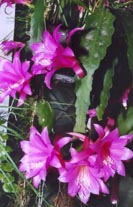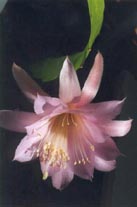 **BOTANICAL
SPECIES AND HYBRIDS**
**BOTANICAL
SPECIES AND HYBRIDS**
DISOCACTUS NELSONII V. HONDURENSIS_____________________HYBRID EPIPHYLLUM "PETITE PINK"
 **BOTANICAL
SPECIES AND HYBRIDS**
**BOTANICAL
SPECIES AND HYBRIDS**
*************************
As I am simply an amateur and not a well-informed botanist, I tried to avoid making as few taxonomy errors as possible in this tricky page, but as taxonomy is for me a particularly slippery ground, I am convinced that well-informed people will probably spot a frightening amount of errors. I apologize and, above all, I beg for their (constructive) help...
BOTANICAL GENERA AND SPECIES
If we exclude the genus Rhipsalis, epiphytic cacti are native from Central America and South America. I indicate here the genera which are present in my collection.
Aporocactus, Disocactus (among which appear Wittia, Chiapasia,
Bonifazia), Epiphyllum (among which Marnieria), Heliocereus (which is saxicolous
or epiphytic), Hylocereus (among which Wilmattea), Nopalxochia, Schlumbergera
(or
Zygocactus), Rhipsalis (among which Acanthorhipsalis, Erythrorhipsalis, Hatiora,
Lepismium, Pfeiffera, Rhipsalidopsis), Selenicereus (among which Cryptocereus,
Deamia), Weberocereus.
Many of these genera easily bloom in collection and have very beautiful and varied blooms.
HYBRIDS
They were created by crossings, sometimes multigeneric, between
the botanical species and they gave plants whose blooms’ beauty and
diversity are absolutely fabulous. Hybrids’ blooming is in itself
a sufficient enough reason to be interested in epiphytic cacti.
To my great regret, I never found any book dealing in detail with the hybrids creation history. The first hybrids were created in the 19th century in England, starting from botanical plants among which Heliocereus speciosus, brought back from America , which sometimes grows as an epiphyte but which is also saxicolous (i.e. growing on rocks, on places which contain humus) and Nopalxochia phyllantoides. The hybrids thus created were highly popular and were exported towards other European countries where new hybrids were also created and where research currently continues, in particular in Denmark and the Netherlands for Schlumbergera. New cultivars appeared, created with the use of other botanical species among which Epiphyllum crenatum and Selenicereus grandiflorus. In the 1900s, seeds and plants were exported to the United States and California became an essential place concerning hybridization. More hybrids were created in Australia (in particular by Joyce Carr) and in Japan.
In my opinion, important imprecisions often exist concerning the epiphytic cacti hybrids denomination. The word Epiphyllum is already carrying a misinterpretation, then this word means that the plant blooms on (epi) the leaves (phyllum). I believed for a long time that Aporophyllum were hybrids between Aporocactus (aporo) and Epiphyllum (phyllum), the reality is much more complex (see my page about history of Aporophyllum). To simplify (?) things, some books call Epicactus all epiphytic cacti hybrids (except for the hybrids of Schlumbergera and those of Rhipsalidopsis). But other names are frequently mentioned. The situation is complex, a lot of hybrids having two, three, four or more genera among their ancestors (Disocactus, Heliocereus, Nopalxochia, Hylocereus, Selenicereus for example, concerning Epiphyllum hybrids)
Among the hybrids genera names which can be found, I will quote:
Heliochia, which are very numerous among Epiphyllum hybrids;
they are crossings between Heliocereus and Nopalxochia. Among the Epiphyllum
hybrids, Heliochia are often recognizable by the number of ribs on their stems
which is higher than two, due to their ancestor Heliocereus (speciosus in almost
cases) ; Aporophyllum have Aporocactus among their ancestors, their stems
look like those of Aporocactus. Aporoheliocereus are crossings between
Aporocactus and Heliocereus, they are often classified among Aporophyllum. Aporoselenicereus
are crossings between Aporocactus and Selenicereus and are also often classified
among Aporophyllum. Disapora are crossings between Disocactus and Aporocactus;
among them we find the very beautiful Disapora X ‘Brilliant’ (see
photo gallery of June). Disophyllum have Disocactus among their ancestors,
often Disocactus macranthus or its glaucocladus variety; among them we find
the very delicate and scented ‘Frülingsahnen’, ‘Frühlingsgold’,
‘Frühlingsanfang’, ‘Frühlingspracht’, ‘Frühlingsrauschen’,
‘Frühlingsstern’, ‘Frühlingstraum’, ‘Märzsonne’
which appear in my photo galleries of May and June. Schlumbergera crossings
are often called Zygocactus (due to the zygomorphic shape of a lot of
them). Joyce Carr (Australia) and Frank Süpplie (the Netherlands) recently
created intergeneric hybrids between Schlumbergera and Disocactus or Epiphyllum;
they received the names of Schlumisocactus for the first ones and Schlumepiphyllum
for the second ones. The hybrids of Schlumbergera are also called Thanksgiving
cacti (cactus blooming for Thanksgiving Day) or Christmas cacti (cacti flowering
at Christmas time), according to their blooming period in the Northern Hemisphere.
To finish, I will talk about the hybrids of Rhipsalidopsis (or Hatiora)
which are often called
Easter cacti in the English-speaking countries. Their vegetative appearance
looks like that of Schlumbergera but the blooming period is different, just
like their botanical ancestors. Schlumbergera and Rhipsalidopsis are very often
wrongly designated by the generic name of Epiphyllum in the French garden centers.
I certainly forgot other names but "the forest of names is already dense
enough ".
HOME PAGE ........................................................................................PHOTO GALLERIES